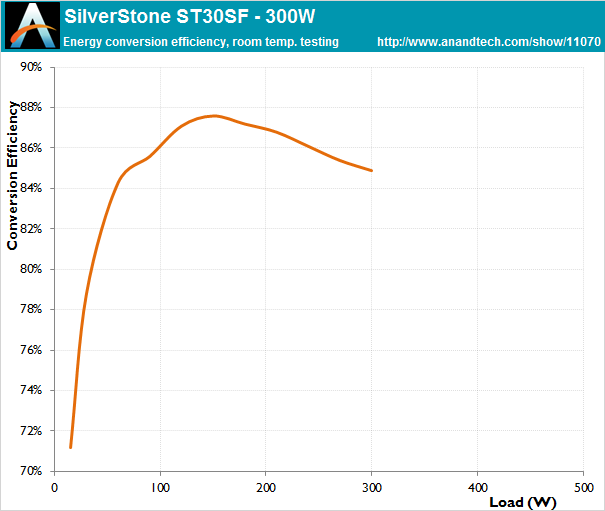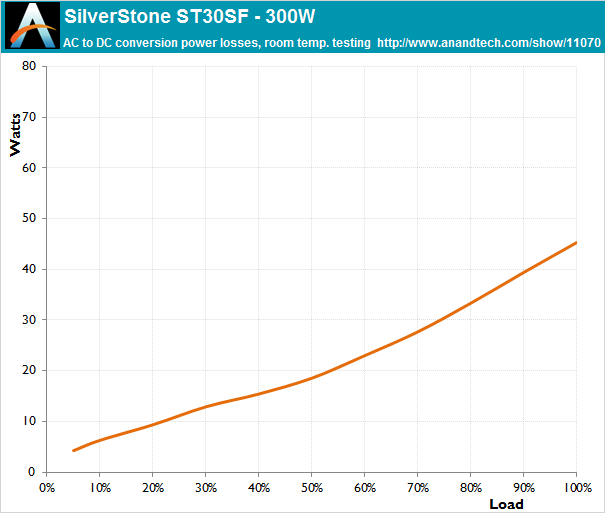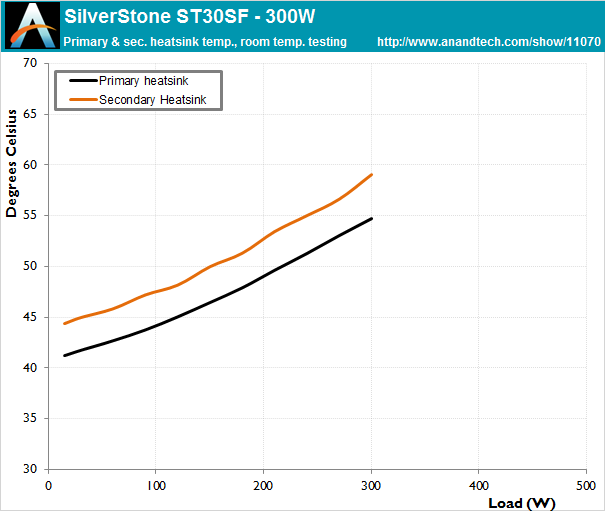The Silverstone ST30SF & ST45SF SFX Power Supply Review
by E. Fylladitakis on January 26, 2017 9:00 AM EST- Posted in
- Cases/Cooling/PSUs
- PSUs
- 80Plus Bronze
- SilverStone
- SFX
- ST30SF
- ST45SF
Cold Test Results
For the testing of PSUs, we are using high precision electronic loads with a maximum power draw of 2700 Watts, a Rigol DS5042M 40 MHz oscilloscope, an Extech 380803 power analyzer, two high precision UNI-T UT-325 digital thermometers, an Extech HD600 SPL meter, a self-designed hotbox and various other bits and parts. For a thorough explanation of our testing methodology and more details on our equipment, please refer to our How We Test PSUs - 2014 Pipeline post.

| Efficiency |
Despite having only an 80Plus Bronze efficiency certification and that we were testing them with a room temperature lower than the standard 25 °C that the testing guidelines dictate, both units failed to achieve even that level of efficiency with a 230VAC input. The maximum efficiency of both units at 50% load is just shy of the 88% figure that they had to reach in order to comply with the certification standards. The platform received its certification rating with an input of 110VAC though, where the efficiency standard dictates a minimum of 85% efficiency at 50% load, not 88%. Even though all switching PSUs are less efficient with an input of 110VAC, it is very much likely that the platform does meet the qualification ratings, even if only barely. Regardless, both the ST30SF and the ST45SF display relatively stable energy conversion efficiency, with an average of 86.1% and 86.3% respectively (within their nominal operational range - 20% to 100% of the unit's capacity). The efficiency plummets at lower loads, diving all the way down to almost 70% at just 5% load.

| Power Losses |
These two PSUs are an excellent opportunity to showcase how picking an oversized PSU can lead to inferior overall performance. With both units based on the same platform but with a severely different power range, the ST45SF is at a great disadvantage with loads lower than 80-90 Watts, whereas the ST30SF come within its nominal loading range with a load of just 60 Watts. What this means is that the ST30SF is significantly more efficient than the ST45SF with a load of about 80-90 Watts or below. By looking at the graphs, we can see that the ST45SF generates significantly greater losses at very low loads due to inefficient operation, making it hotter and louder than its much less powerful sibling. This is an excellent example of how an unnecessarily oversized PSU can be actually detrimental.

| Intake & Exhaust Air Temperature |

| Heatsink Temperature |
From the sound pressure level graphs, we can see that both units reach about the same maximum noise output when operating in room temperature, although the 450W model does so with an output that is 50% greater than the 300W model. The operating temperatures of the ST45SF are however a little higher, hinting a slightly laxer cooling profile.

| Sound Pressure Level |










30 Comments
View All Comments
hasseb64 - Thursday, January 26, 2017 - link
Bronze? Wouldent installed one for free...A5 - Thursday, January 26, 2017 - link
The difference between Bronze and Titanium at 450W 100% load is 36W (roughly $38/year if you run 100% 24/7/365).Which isn't nothing, but it isn't a huge deal down in this power range.
TurboTastic - Thursday, January 26, 2017 - link
I totally would install one for free, and $45 is close enough to free to make it an easy choice!Yes, bronze is the minimum of the 80Plus certification. But it still means that it's 80Plus, which is better than a lot of the competition at this price point.
And what do you lose? 10W on standby, or 20W during the few minutes a day when you're really pushing the little Celeron kiosk you'd put this into? You could spend $90 on a Corsair SF450 Gold unit, or $160 on a Silverstone Platinum SX700. Even if those units had zero standby power consumption (they don't, the platinum still burns like 7W on standby), that $45 difference would buy like 4 years of electricity. You could run it for more than a decade on the SX700 before breaking even.
It's the right choice for the sign-in kiosk in the lobby, or a thin Word/Excel/Outlook client in the office. It's a fine choice for a NAS, or a media server in a closet. This is the right choice for the little Facebook machine you want to build for Grandma. And I depend on reviews like this from Anandtech so I can pick quality budget components for those machines! I'd probably be looking for a 300-500W ATX form factor power supply for 80% of my builds, and a small form-factor PSU like this one in this same power range for another 15%. Only a tiny fraction are the monster workstations and servers that need big, efficient power supplies.
Thanks, Fylladitakis, for another review of a typical power supply!
DanNeely - Thursday, January 26, 2017 - link
The minimum level is just 80 Plus, Bronze is the first step up above it. That said, especially at the 300W level just 80+ Bronze is better than most of what's on the market. Especially since this appears to be a modern 12V first design, vs a lot of the other junk on the market being old split rail designs.https://en.wikipedia.org/wiki/80_Plus#Efficiency_l...
80-wattHamster - Monday, January 30, 2017 - link
80+ is a certification based solely on efficiency, and has nothing to do with output quality or durability. It's true that in today's market, the marketing pull of 80+ being what it is, that a non-rated model isn't likely to be any good. But the rating by itself is nigh-meaningless in determining if a given unit is any good.romrunning - Thursday, January 26, 2017 - link
The SG05 that I bought with the 450W SFX PSU is still going strong. I really don't hear the fan in the PSU at all. It seems to be quieter than the CPU's fan in this min-ITX case.hybrid2d4x4 - Thursday, January 26, 2017 - link
Thanks for reviewing these smaller, relatively lower-power-rated PSUs!Props for the segment on "how picking an oversized PSU can lead to inferior overall performance", though I find it odd how this never gets mentioned in the reviews of idiotically oversized PSUs that are positioned at mainstream users (600-700W). These units get panned for being only bronze efficiency, but in the power draw situations of single-GPU systems, they would be a lot more efficient in the idle/light-usage state and possibly better while gaming compared to a PSU that is only at 30% load (in the case of a 700W).
StrangerGuy - Tuesday, January 31, 2017 - link
Yeah, it's really funny and idiotic with all that "ZOMG you need a 600W+ PSU or your PC will explode" PSU memes all around....For a typical gaming single GPU PC that idles ~50W and maybe touch 300W at full load where a 600W+ PSU will run so far away from the sweet spot on the efficiency curve.phexac - Thursday, January 26, 2017 - link
I generally stay away from commenting on the actual items you guys review, but I have to wonder here...how many people actually care about power supply reviews? Seems like there are plenty of other things to review out there...galta - Thursday, January 26, 2017 - link
Maybe the do not care, but they should.